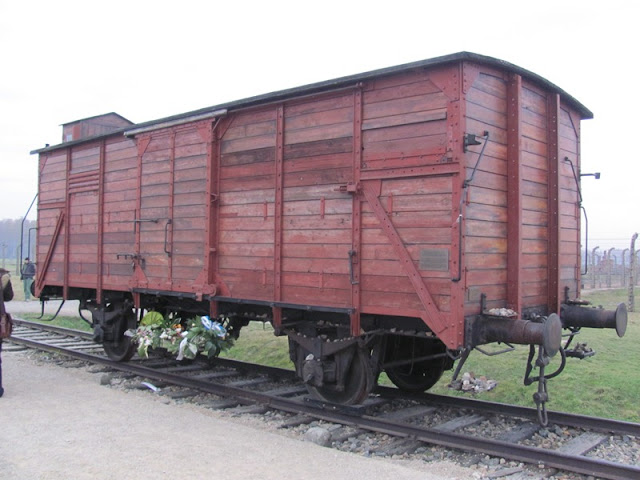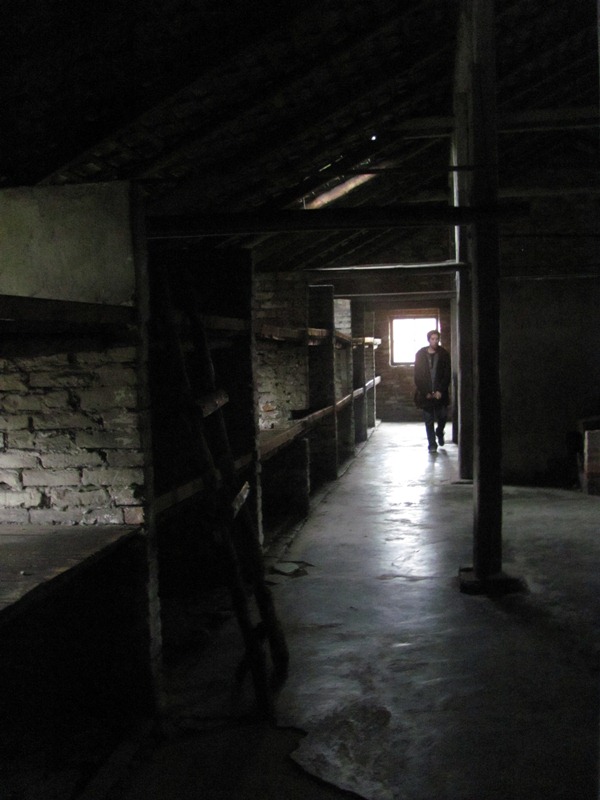Our trip to Auschwitz and Birkenau wasn't the easiest tour I've ever taken and at points upsetting but it's one it's good to have made. I can't imagine that anybody isn't aware of the terrible things that happened there during the war but being there doesn't half bring home the terrible and quite unbelievable depths of cruelty that people can bring themselves to.
Auschwitz itself was a polish army camp that the Germans enlarged to use as a concentration camp.
Each prisoner was allowed to bring a certain amount of luggage with them which was promptly taken off them when the arrived. Auschwitz had quite an industry in sorting out and selling on the luggage. What remained after the war was only a small porportion of it.
From a large cabinet of suitcases
Can't say I was ready for the room that has a case containing several tons of human hair which equated to the hair of over 40000 people. All the prisoners to the camp had their head shaved and the hair went on to be woven into cloth and sold or used for stuffing.
Childrens' shoes
This is a cell for standing which has been partially deconstructed so that the inside can be seen. 3 or 4 prisoners at a time would be sentenced to these so there would be no room to lie down or sit. They would have been required to crawl in and out of the small hatch you can see at the bottom. As if this wasn't enough, they would still be required to come out during the day and do a days work.
The gallows where recaptured, escaped prisoners would be hung in front of the whole camp.
Outside the has chamber.
Inside the gas chamber.
The crematorium which was rebuilt after the war by Jews from the original parts.
The camp comander was captured after the war and returned to Auschwitz where he was hung on these gallows.
A few miles away is a considerably larger camp at Birkenau, sometimes known as Auschwitz 2
Towards the end of the war to speed up the "processing" of prisoners the railway lines were extended into the camp and prisoner were sorted out in the camp into those that were to be sent straight to the gas chambers and those deemed fit to work.
A refurbished railway carriage of the sort used to ship prisoners.
Seven days from the liberation of the camp, the gas chambers and crematorium were blown up in an attempt to cover up what had been going on in the camp. These have been kept as they were found as a monument to those that died there.
Gravestones in 4 languages, Polish, English, Hebrew and Yiddish, erected in front of one of the pits used to dispose of human ashes.
Some of the Brick built huts at Birkenau. The grass wouldn't have been there during the war due to bad drainage, it would have been Mud or frozen over.
Sleeping shelves in the brick huts, which would have slept several people on 3 different levels including the floor (the concrete on the floor is a recent addition)
Most of the huts at Birkenau are these wooden designs which were quickly found to be much cheaper to build.
The latrines in one of the huts.
Inside one of the huts with sleeping shelves.


































12 comments:
I don't think I could visit either place. After viewing your photos, I now know I could not.
Thanks Sandy, very nicely put together, and very moving. I think I would find it hard to go there, as well.
Thank you for this blog Sandy, my daughter visited both camps with her school a couple of years back, she was very moved by what she saw, and seeing your photos I can understand why. I would go and visit, although I am sure it would upset me - my daughter told me about the hair and the shoes.... these atrocities should never been forgotten, ever. My heart goes out to all the innocent people who lost their lives there and in other concentration camps.
The post is much appreciated. Thank you. I couldn't help but notice one suitcase marked "M. Frank Holland." Could it possibly have belonged to Margot, Anne Frank's sister?
Sandy, I have shared your post at Google+. I hope that was OK. The post is important and the photos are moving.
https://plus.google.com/107934062117327617121/posts/Eo6hUChRPQy
Upsetting and moving: finely rendered.
The horror of these places is nearly unimaginable. Even worse are those who insist these atrocities ever happened, Mahmoud Ahmadinejad for one.
Thank you all for your comments - It quite important that we don't just look at the things that are lovely and easy in life, thus this trip and blog.
Dave, feel free to post the blog where ever you want.
Chip. It is, I'm afraid, a fact that certain people say this didn't happen. They are at best deluded but I suspect they're just lying through their teeth. Probably just ignoring them is the best thing to do.
Hi Sandy,back in the 60's while serving with H.M Forces we were bivvied up at Honhe for a few days and were given a quick tour of Belsen.
While nothing like the scale of Auschwitz it was a very sobering experience.
We humans still have a long way to go.
Proof isn't enough for the who deny the holocaust.
Sandy, thank you for this post. There are those in the States who deny this happened, but far more who say it never could happen again. They are wrong, and remembering is one way to stand against a new holocaust.
Thanks for the detailed tour. I visited both Auschwitz and Birkenau when I was in Poland, a most upsetting and moving visit...
Sandy, such a moving post. So that each & every one of us remembers all the precious lives so sadly lost, these are images that should never be hidden. thank you for this.
Post a Comment